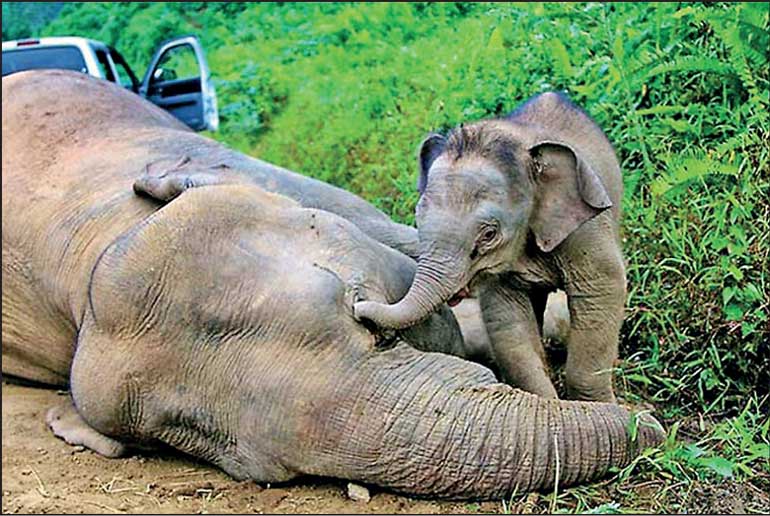Tuesday Apr 22, 2025
Tuesday Apr 22, 2025
Wednesday, 27 October 2021 00:00 - - {{hitsCtrl.values.hits}}

Alluding to the requests by the President and the COPA, urging a quick and durable solution with policy changes to protect humans and elephants, the writer suggested a long-term solution to HEC (human-elephant conflict) by way of determining the optimum manageable number of wild elephants in Sri Lanka through research, and exporting the excess, thereby opening an avenue to earn much needed foreign exchange too.
I have since been informed that the export of elephants has been restricted by the State, as well as the rest of the world. If it is so, the necessary policy changes as indicated by COPA should be done firstly at our end, to remove such restrictions, and thereafter convince the rest of the world on the need to preserve a balance in the universal elephant population. If not, are we to continue with the hackneyed harmful and temporary strategies like elephant-chasing crackers, electrical fences, trenches and bee-boxes etc., which are fast becoming wasted investments in the face of these wild elephants that have become wily and aggressive due to the natural compulsion to douse their hunger? Conversely, the unabated reporting of seemingly vengeful killings of humans and damage being done to property, harvest and laboriously cultivated plots of those helpless, poor farming populations, are utterly disgusting and heart wrenching! In such circumstances, those farmers treating the wily and arrogant elephants as their enemies seem justifiable!
As stated in my previous submission, ongoing research by the Dept. of Wildlife Conservation (DWC) and Agricultural Biotechnology Centre (AgBC) of the University of Peradeniya has revealed that carrying a wild elephant population numbering between 5,000 and 6,000 is relatively high for a small country of 65,610 Sq. km inhabited by a human population of nearly 22 million. Does our public know that an elephant consumes about 150 kgs of vegetation per day? With an estimated 5,600 wild elephants as at present, their food requirement works out to an astounding 840,000 kgs per day! How can a small developing country like Sri Lanka cope with such daily consumption levels when the human food, cultivable land and habitat requirements are also increasing exponentially?
More long-term measures
While we all agree that elephant conservation (EC) is of crucial importance, the growing imbalance between the increasing populations of humans and wild elephants is quite evident from their ever-increasing death rates despite expensive counter measures. Therefore, in the face of Sri Lanka being a small, developing country with depleting resources, the only and best way is to strike a delicate balance between the two populations. We fervently hope that the said research findings will finally throw enough light to convince those vociferous but sincere elephant conservationists and environmentalists to appreciate this bitter ground reality. In the meantime, the following alternate long-term measures are suggested towards reaching the said delicate balance:
1) In the face of export restrictions for elephants, initiate effective neuter/birth control programs.
2) After determining the country’s optimum area-wise, easily manageable number of elephants for EC purposes (at least at 10-year intervals) use our foreign Ambassador network or Govt.-to-Govt. discussions to export our excess elephants to zoos in foreign countries, which I believe is not restricted. If such elephants are exported in couples, the wildlife enthusiasts in those countries will surely help to prevent Sri Lankan elephants becoming an endangered species.
3) Effect policy changes as aforesaid and negotiate with the concerned countries to remove or relax the existing restrictions on a case-by-case basis.
Benefits accruing to the country
1) Redeeming those poor farmers from their present plight of misery resulting from research related relocation exercises of elephants.
2) Additional availability of safe habitable and cultivatable land to the increasing human population in the medium and long-term.
3) Saving considerable volumes of jungle vegetation and food crops, arising from the rationalisation of the wild elephant population.
4) Reduction of wasteful foreign exchange on electrical fences, elephant-chasing crackers, anaesthetics and manpower etc., which are inimical to wildlife.
5) Opening a new avenue to earn much needed foreign exchange.
6) The savings can partly be utilised to catch, tame and export (CTE) the elephant surplus.
Conclusion
The adoption of the above mentioned long-term, non-invasive strategies will surely contribute towards solving many of the practical problems of HEC and EC, while helping to meet the country’s main food and habitat requirements, as well as mitigate the current foreign currency/debt repayment problems.
(The writer can be reached via email at [email protected])
Discover Kapruka, the leading online shopping platform in Sri Lanka, where you can conveniently send Gifts and Flowers to your loved ones for any event including Valentine ’s Day. Explore a wide range of popular Shopping Categories on Kapruka, including Toys, Groceries, Electronics, Birthday Cakes, Fruits, Chocolates, Flower Bouquets, Clothing, Watches, Lingerie, Gift Sets and Jewellery. Also if you’re interested in selling with Kapruka, Partner Central by Kapruka is the best solution to start with. Moreover, through Kapruka Global Shop, you can also enjoy the convenience of purchasing products from renowned platforms like Amazon and eBay and have them delivered to Sri Lanka.
Discover Kapruka, the leading online shopping platform in Sri Lanka, where you can conveniently send Gifts and Flowers to your loved ones for any event including Valentine ’s Day. Explore a wide range of popular Shopping Categories on Kapruka, including Toys, Groceries, Electronics, Birthday Cakes, Fruits, Chocolates, Flower Bouquets, Clothing, Watches, Lingerie, Gift Sets and Jewellery. Also if you’re interested in selling with Kapruka, Partner Central by Kapruka is the best solution to start with. Moreover, through Kapruka Global Shop, you can also enjoy the convenience of purchasing products from renowned platforms like Amazon and eBay and have them delivered to Sri Lanka.